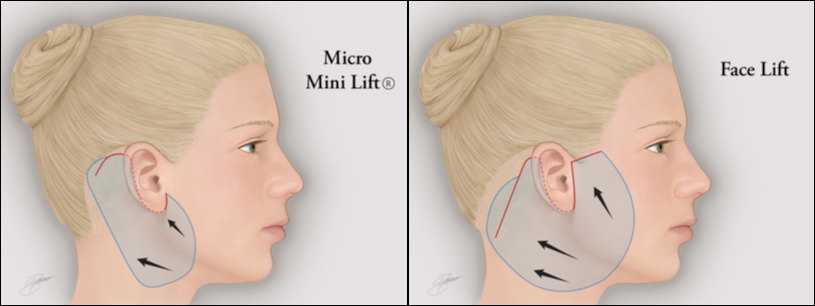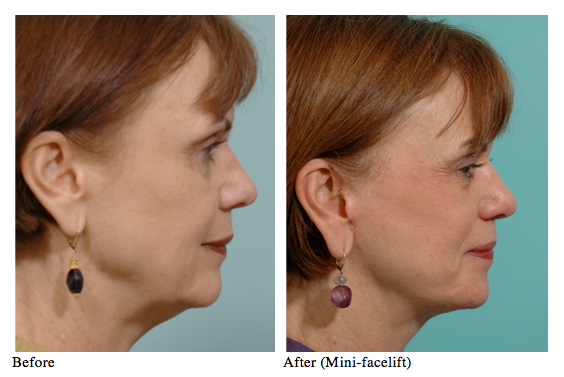Facelift Overview
The facelift procedure both improves wrinkling caused by loose skin, and also lifts and tightens the face and neck tissues, which tend to sag increasingly with advancing years.
As medical advances, better nutrition, and exercise increase the life span, many aging women and men find that they look older than they feel. The popularity of the facelift stems from its ability to turn back the clock on jowls and wrinkles.
The amount of improvement from surgery depends on the degree of wrinkling. If wrinkling is significant, results may be dramatic. If sagging is just starting and the operation is performed to keep the patient looking young, the improvement may be more subtle, causing friends to remark that the patient “just looks better.”
In some people, fat gradually develops below the chin to make a “double-chin.” The mound of fat obliterates the ideal chin-neck line and contributes to the appearance of aging. Other people have a “turkey-gobbler” deformity, consisting of several vertical bands which run from the chin to the base of the neck. Both problems can be addressed during the facelift procedure.
Lasting Results from a Facelift
A commonly asked question is: “how long will my facelift last?” The answer is that there will always be some positive effect: the patient should always look better than he or she would have at any given age. The facelift sets the clock back, but the clock continues to run. Another great benefit of the facelift — one that often justifies it being done as early as the patient’s 40s as part of a preventive maintenance program — is that the patient can maintain a youthful appearance for the rest of his or her life, simply by having periodic “tuck-ups” every few years. These relatively minor procedures are usually followed by very little swelling and discoloration, and downtime.
Facelift Surgery
The facelift operation is usually performed under sedation (not general anesthesia!) in our office Operating room. Patients usually go home on the same day with our nurse who has been extensively trained in taking care of Dr. Godin’s patients. It is a great comfort for the patient to have an experienced expert on hand to maintain comfort during the initial recovery.
The patient is able to wear makeup one week after the procedure and by two weeks is usually presentable enough to go to any occasion. Sutures are removed during the first week after surgery. In a short time, the scars, most of which are hidden in the hair and behind the ears, become inconspicuous except upon close scrutiny.
13 Most Commonly Asked Questions by Facelift Patients
1. Am I a candidate for a facelift?
There is no one facelift and most people from their mid-40s on can benefit from some degree of firming of the neck and/or jawline. This varies of course, by the patient’s individual appearance, their genetic history, and the amount of sun exposure they have had.
2. Are there different types of facelifts?
Absolutely. A facelift may involve improving the contour of the neckline, improving the jaw line and removing jowls, reducing the depth of facial folds such as the nasal labial fold and “marionette lines,” and improving the size, position and definition of the cheeks. The important thing is that the surgeon has the experience and aesthetic judgment to choose the correct type of lift for the patient.
3. How long does a facelift take to perform?
Approximately three hours, although this can vary depending upon the amount of work that needs to be done and whether it is a first-time lift or a revision procedure.
4. Speaking of revision procedures, how often are they necessary? In other words, how long does a facelift last?
A facelift lasts for a patient’s entire life in that the patient will always look more youthful for having done it. In the facelift procedure, the deeper tissues are tightened and excess facial and neck skin is actually removed so there is simply less tissue remaining to sag. Having said this, the facelift turns back the clock and does not stop time. Patient’s necks and jaw lines continue to change over time and it is not unusual for a patient later in life to want further improvement of these areas. The important consideration is that this should not be done too often or too soon and also in revision lifts there are some technical challenges that an experienced surgeon will know how to overcome.
5. Does the facelift procedure hurt?
The procedure does not hurt at all. The patient is under anesthesia. After the procedure, most patients say there is mild discomfort. This takes the form more of tightness than actual sharp pain. It is normally easily manageable with pain medication, which becomes less necessary after the first 24 to 48 hours.
6. Will I have bruising after a facelift?
Yes. Most patients do have some degree of bruising. It varies depending on the patient’s genetic makeup and any medications that they may be taking as well has how large an area required correction.
7. When am I presentable?
Patients are normally presentable 10 days to two weeks after a standard facelift and sooner after a smaller modified lift such as the Micro-Mini Lift®. I tell patients that they should easily be back to work and meeting clients within two weeks and can attend their daughter’s wedding in three weeks.
8. What is the cost?
The cost varies depending upon the amount of work to be done and is quoted individually for patients at the time of their consultation.
9. What type of anesthetic is used?
In my office, all of these procedures are done under intravenous sedation administered by a board certified anesthesiologist. This means that the patient does not have general anesthesia. There is no tube down the patient’s throat and none of the anesthetic gases are used. The patient is simply very relaxed by I.V. medications and then local anesthetic is added to keep the patient comfortable and sleepy during the procedure.
10. Do I have to go to the hospital for this procedure?
No! My office has an operating suite accredited by the American Association for Ambulatory Healthcare. The vast majority of our facelifts and other cosmetic procedures are performed there in a clean, safe, and efficient environment.
11. Are surgical drains used?
No. I have not used surgical drains in facelift surgery in over ten years. My facelift technique is a meticulous one in which all bleeding is stopped immediately by using electric cautery. This is the equivalent of “cleaning the kitchen as you go” rather than at the end. It takes a bit longer to do the surgery this way but the patients have less bruising and an easier recovery.
12. What do you like about a facelift?
I enjoy the facelifting procedure tremendously. In fact, it is my most common surgical procedure. It is always gratifying and sometimes amazing to see 10, 15, or even 20 years come off of a neck or jaw line on the table. I get to see the beauty of the patient’s underlying structure and show it off to the world.
13. I understand that you are a sculptor as well as a physician. Has this influenced your facelift procedures?
Yes. I do enjoy sculpture and work mainly in clay. In this endeavor, I am actually creating something that I hope will become beautiful out of a shapeless mass. It is a different kind of challenge than correcting existing aging or deformity. It trains the eye and the mind in a different way and I believe it gives me a better aesthetic sense that helps me deliver a beautiful result for my patients.


 Q: What is the Micro-Mini Lift®?
Q: What is the Micro-Mini Lift®?